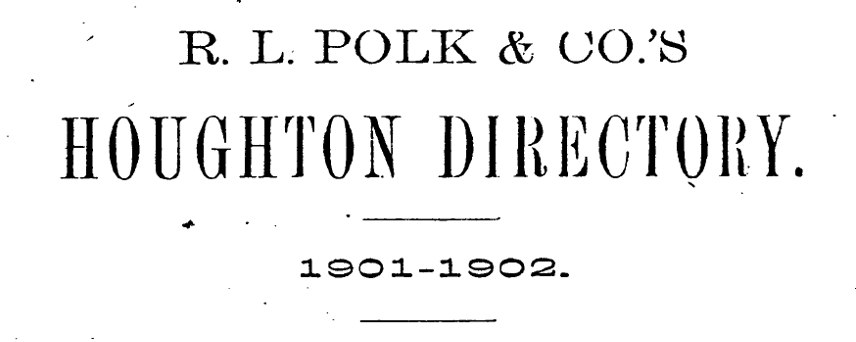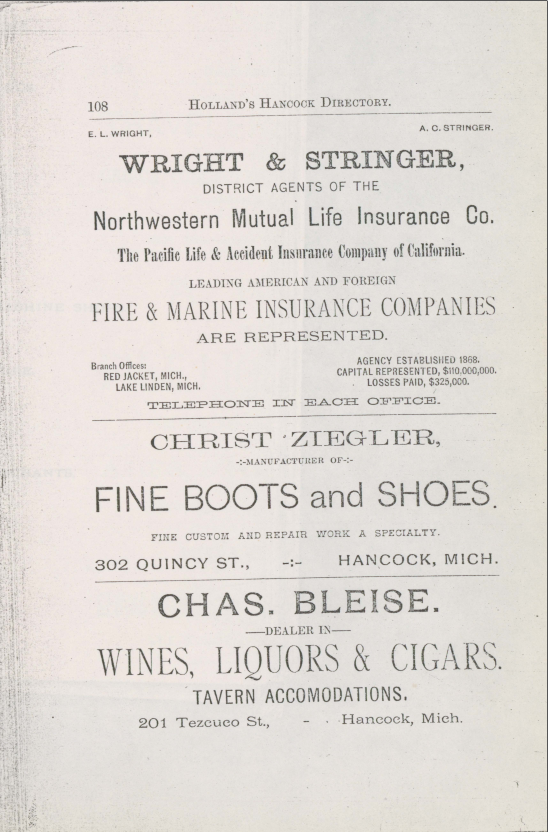|
This is part 1 of a 3-part blog series introducing the new historical directories that you can explore in the Keweenaw Time Traveler. Which historical records go into the Keweenaw Time Traveler? What does it take to add them? What are the pros and cons of each record? There is no such thing as a perfect historical document. We know visitors to the Keweenaw Time Traveler use data to answer a variety of questions, and many of our Citizen Historians are researching their families within the Copper Country. Those of you researching your families understand how often you need to play detective when examining old records such as the US Census. The name might be similar in multiple documents while the location or age does not match. The Keweenaw Time Traveler team does the same kind of detective work, but we get some help from our databases. By combining archival records with historic maps, we can check and double-check that we are placing the right person at the right location. The more information that gets added to the Keweenaw Time Traveler, the more confidence we can all be about its accuracy. What were city directories? It might be easier to start by saying what they weren’t. Historic city directories were not phone books. Telephones were not commonplace in American homes until the 1920s. Before phone companies existed, directories were privately published. Polk & Co, a national company published many of the Copper Country directories. In other cities, local printers developed their own directories as a side project as a means of earning advertising profits. With different printers creating directories, we see various publishing schedules. Some cities, like Detroit and Toronto, had yearly updates. Less populated areas might see updates only every few years depending on printers and the potential for profitability. Businesses purchased space featuring their business information in a prominent advertisement or pay to have special formatting to capture the eye of readers, similar to how websites today pay to appear first in search results. What did they contain if there were no phone numbers? While the information published varied by printer, most directories list the head of household’s name, their occupation, followed by addresses for both their residence and place of employment. In Polk & Co’s Houghton Directory, the information is limited to name, occupation, and residence. While we use the phrase city directory, many directories expanded to include rural areas by the 1860s. When a directory only listed a residential address, the head of household might be retired or not working. If only an occupational address was listed, the canvassers were unable to confirm a person's residence prior to publication. Women were included in directories when they maintained an occupation or were heads of household. There are a great deal of abbreviations used by printers to explain the dense information found within each entry. Before using any directory, take the time to read over the abbreviations and become familiar with what is, and isn't, explained. Many common names are abbreviated which can require some additional detective work. Printers also abbreviated occupations to conserve space. How did the printers get their information? To prepare a new edition of a directory, printers sent out canvassers with the old edition of the directory broken down by an area. These individuals then went door to door verifying the occupants’ information. Canvassers made at least three attempts but would also resort to checking with neighbors for occupant information. The Toronto Star published a wonderful article in 1913 explaining how the Toronto City Directory was updated and published. The article provides a wealth of information on the canvassing methods, enabling you to better understand the strengths and weaknesses of it as an archival resource. What's Next? In Part 2 of our blog posts, we will explore the specific City Directories we used within the Keweenaw Time Traveler Explore app, and we will discuss the Business Directories we recently completed mapping. This is a perfect time to browse your community and see how it has changed during the last 100 years. These directories are all available so go explore and see what you find! More Information:
A few of our favorite additional resources on directories... Ancestry.com- “5 Tips for Getting the Most from City Directories.” Amy Johnson Crow maintains a website on genealogy, and she presents an explanation of farm directories specific to New York Counties. While these directories are dramatically different from the Polk City Directories for the Keweenaw, they demonstrate the variety in appearance and information. The Library of Congress maintains an extensive collection of historic directories. These directories are not available on-line, but some general information is available on their bibliographic guide.
1 Comment
Kim Sweet
11/25/2020 09:20:08 am
My Great Grandfather met his wife in a copper mine up there years ago. Mortz and Mary Weber. After leaving there they settled in Beal City Michigan. To were my family still resides today. My Dad was named after a gentleman that ran the mine I was told, Edward. ... I think I have the right names ... I'd have to go back through the history book my Uncle Ben made to double check.
Reply
Leave a Reply. |
|



 RSS Feed
RSS Feed



